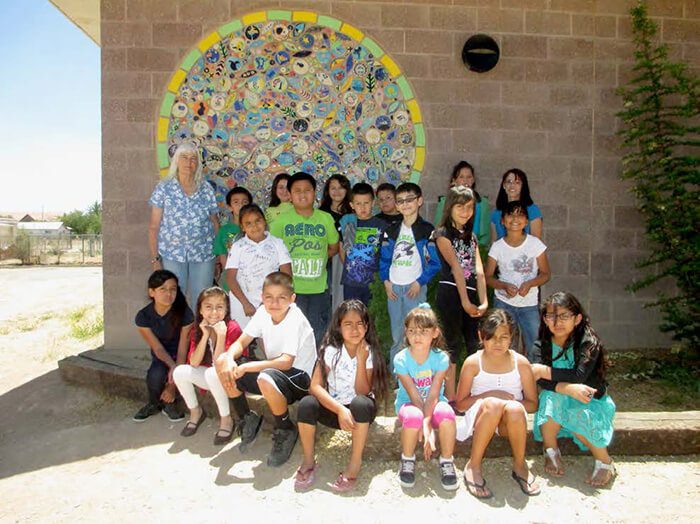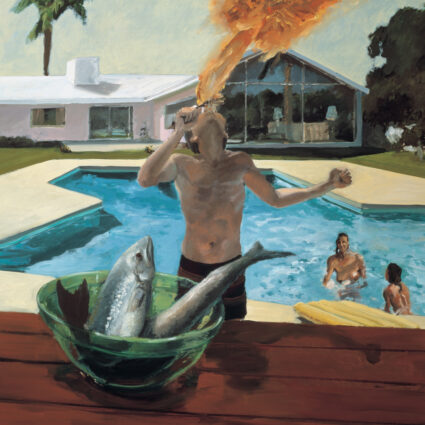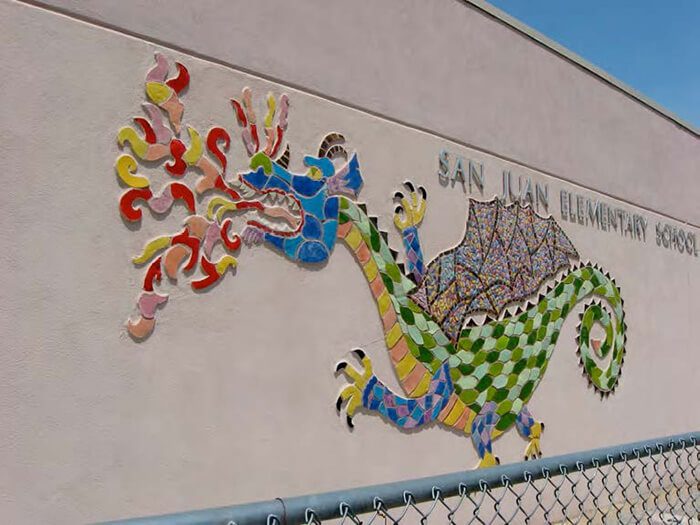
Last summer I met up with artist Sabra Moore at Angelina’s Restaurant, with the big chili pepper sign, on Fairview Street just by the Rio Grande in Española. We were about to tour the district elementary schools where she has been working to create large, permanent tile wall mosaics created from individual paintings by the school children throughout the rural area.
Moore is a powerhouse of Northern New Mexico public art. She works in the landscape of Georgia O’Keeffe—Moore herself lives not far from Abiquiú Realty where visitors catch the bus for the O’Keeffe House Tour. It’s more popular every year. But art devotees hardly know what else they are missing in the area.
Moore was a central figure in the feminist art movement in New York City from the 1970s through the 1990s and active in numerous tactical art groups including REPOhistory (a group that placed “commemorative” signs marking little-known historical events in marginalized neighborhoods). She was also at the center of legendary women’s art movements like the Women’s Caucus for Art, still today the largest professional organization of women artists, art historians, and museum professionals; and the collective that published Heresies: A Feminist Publication on Art and Politics from 1977 to 1992. She was a regular contributor to that journal, beginning with Heresies #13: Earthkeeping/Earthshaking: Feminism & Ecology, and she is featured in the 2011 documentary The Heretics (dir. Joan Braderman). Her recent memoir/chronicle of those years, Openings: A Memoir from the Women’s Art Movement, New York City 1970-1992, was published by the New Village Press in 2016.
As Moore became a familiar face in the Reagan-era Manhattan art scene, among the vanguard of feminist artists, she worked in drawings, paintings, and handmade books, mostly, but she also worked collectively, a method connected to the discourses surrounding women’s work. She created numerous group exhibitions, notably an installation called Reconstruction Project in which twenty women from diverse backgrounds used the Mayan Dresden Codex (one of only four existing) to make an homage to the vitality of Mayan culture. The codex’s form served as the basis for a thirteen-foot-long folding book and four directional 7 x 3-foot wall works (for points of the compass). The show was exhibited in New York, it traveled to Montreal and Halifax, and the book was exhibited at the Museum of Modern Art. In this way, Moore specialized in working with other artists to incorporate themes that resonate with specific cultures and places. As she tells it, “Collaboration has always been part of my art practice. I grew up with the quilt-making of my grandmothers in East Texas, standing around the bed as my grandmother would lay out a pieced top she was making and we would all discuss ideas for borders or tell stories about the fragments we recognized from our re-used clothes. The idea of collaboration was a central idea in the feminist art movement in New York. We were trying to figure out our context and find the traces of women artists in art history.”
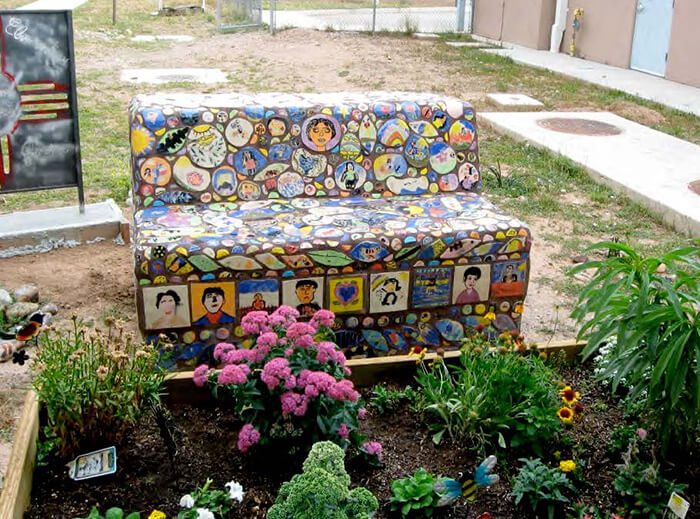
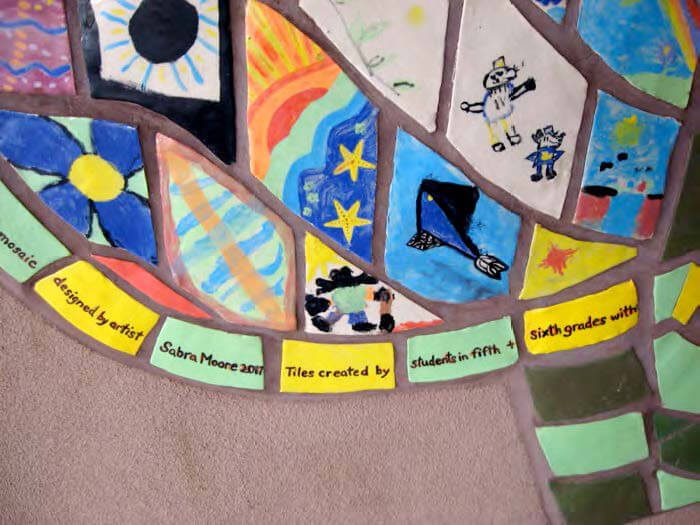
In the nineties Moore and her husband Roger Mignon (also an artist) left New York City for New Mexico as had her friends May Stevens, Harmony Hammond, and Lucy Lippard. The couple settled in rural Abiquiú, but the closest town is Española, a micro city of under 11,000 founded as a railroad village in 1880. After the railroad declined and many historic buildings were torn down in the 1980s, the town’s modest growth included workers from nearby Los Alamos National Laboratory. The area’s populations are diverse in the extreme, including not only Hispanics, Latinos, and Tewa, but also one of the most diverse Sikh populations on the planet.
When Moore and Mignon built their home in Plaza Blanca, under its white cliffs, they had to camp out until the plumbing arrived, and Moore created a spectacular colorful bathroom. “I tiled it like a quilt,” she told me, “going to Lowes Home Center for plain white and beige tiles and to Artesanos in Santa Fe for Mexican tiles—all 3” square. I had the idea of patterned images irregularly within a white/beige field.” She also immersed herself in local art and published a book of photographs of ancient rock drawings (Petroglyphs, 1998). She soon met artist and neighbor Iren Schio, a mixed-media artist who was teaching some art classes in local schools. Moore began working with Schio in 2004, helping her teach painting and mosaics to fifth grade students at James H. Rodriquez Elementary School. Moore inspired the students with photographs of Aztec drawings. Then Schio was invited to do a mosaic in San Juan Elementary by Roger Montoya, who, with Principal Ruby Montoya, helped start the artists-in-public-schools program for the whole Española Public School District. Schio asked Moore to collaborate on an initial project called Driveway Tiles, named for the school bus access way where they are located. At first Moore wasn’t sure she had enough ceramics experience but Schio said “I’ve seen your bathroom!” By now it might be the most famous artist’s bathroom in New Mexico. So Moore and Schio worked on the Dragon-themed mosaics (representing the school mascot) for San Juan’s new building.
After Driveway Tiles came other projects, mostly spearheaded by Moore herself. For the last nine years, she has met with principals of the various schools in the vicinity, from Abiquiú to San Juan Pueblo, one by one, to present her proposals for tile mosaics funded through the State’s artists-in-the-schools programs. Her only compensation, a small salary written into the grants, which usually goes back into the projects for materials and services, like the cost of firing all the tiles at Sunrise Ceramics in Española.
When she took me on our summertime tour, I saw the sublime Northern New Mexico landscape but little monumental art, and architecturally the area seemed quite humble. Until I saw the schools. These are mostly simple and built with small budgets—from Hernandez Elementary school, built by the WPA, to the modern Alcalde Elementary built in 2013. But the mosaics that now adorn their walls inside and out, are colorful and spectacular, and bear rich aesthetic values. They come as surprises—they are brilliant, like gems in rough ground. But there are no “wall texts” to identify them as works of art.
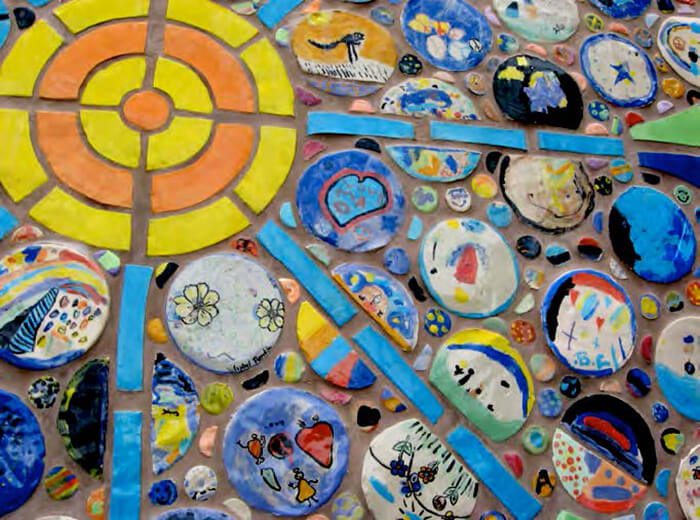
As wonderful as children’s drawings are, in quantities they can sometimes become monotonous to adult eyes. But in these ensembles each piece comes to life. Moore’s and her students’ imaginative amalgamations take on symbolic themes like insects and birds, and leopards and dragons—the latter are the mascots of two of the schools. I couldn’t help thinking, each tile reflects an expressive identity at some stage of emergence, like a molecule of awareness growing within a larger organism. And the students know they are contributing to something that will last. She told me, “My studio art also involves combining parts to make a whole. It is the way I think, so it was natural to transfer that concept to working with children. Many of these children have difficult lives, so I wanted to make something beautiful and joyous with them. I wanted the children to feel that when we work together, they can be part of a something much bigger than they could make alone.” Carmen Campos, who taught at El Rito and helped Moore get two commissions there, agrees. She wrote me recently and described it as validation for the lives of the children, and solidifies their activity at a particular time and place in a way that would live on. “The sense of pride and belonging, such an amazing feeling is preserved in the tiles.”
Moore’s projects begin with students’ drawings: “We started making mosaics exclusively with rolled-out clay cut into patterns. That way, the students create an entire mosaic that fits together like a giant puzzle.” She turns the drawings into patterns, then the students roll out the clay on small boards and cut the patterns and place the clay shapes between boards and cloth to dry for a week or so. Then students paint the clay pieces, using their drawings as guides. Moore takes the tiles to Sunrise Ceramics for the first firing. “Every tile gets fired twice: low fire and high fire. The clay I still use is a high fire outdoor clay that Embudo artist Shel Neymark developed, called Shel’s Clay. It is very durable and long-lasting.” Moore assembles the tiles to form the larger shapes of flowers, leaves, or even lightening bolts.
One year, after El Rito kindergarten teacher Denise Archuleta was killed by a drunk driver, Moore created a memorial banco covered with portraits and symbols made by grieving students and their teachers. But most of the mosaics embellish the schools’ interior and exterior walls. Moore calls them “wall quilts” to convey their connection to the collectivist art projects of the women’s movement. Inspired by quilts, she uses techniques she knows well and now repurposes. When she lived in New York she exhibited and curated countless exhibitions of handmade books, constructed sculptures, and installations (her own work and others’) and her artistic and political legacy is now being archived as the Sabra Moore NYC Womens Art Movement Collection at Barnard College.
In Northern New Mexico, Moore is curating a great exhibition chain of important collectivist art works that span a decade. They stretch from school to school, year by year, and these works are always on view for those who seek them out.
